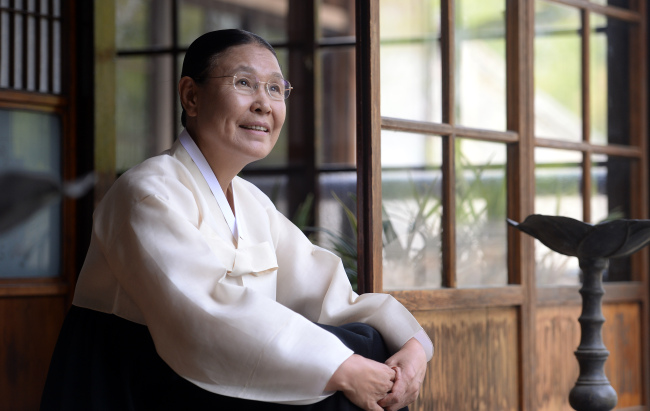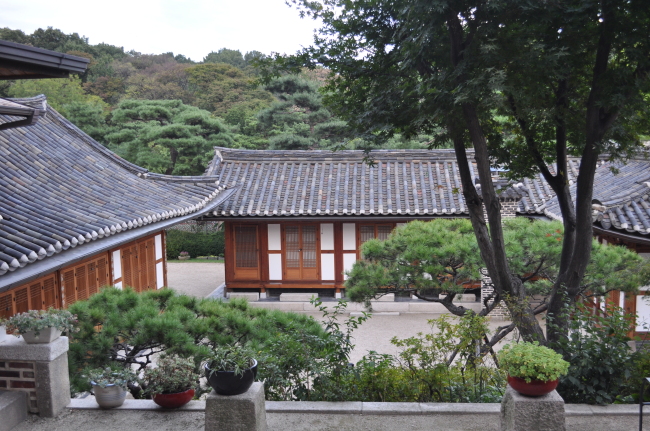[Weekender] ‘Religious leaders should provide stability’
Won Buddhist Rev. Lee Seon-jong lambastes clerics for their greed, calls on mothers to set the country right
By Korea HeraldPublished : May 30, 2014 - 20:57
Located across the narrow street from the western wall of the heavily wooded Changdeokgung Palace, Eun Deok Cultural Center is an oasis of serenity in the bustling metropolis of Seoul.
Overseeing this rare gem is Lee Seon-jong, 70, a Won Buddhist priest who has occupied many of the top posts in the indigenous Buddhism founded by Master Sotaesan in 1924. While the center is operated by Won Buddhism, there is no trace of religion here.
“It is run as a cultural center, not a house of worship,” explains Lee on May 22 at the main parlor of Inhwadang, a traditional Japanese-style construction perched atop one of the center’s five “hanok,” or traditional Koreah houses.
Overseeing this rare gem is Lee Seon-jong, 70, a Won Buddhist priest who has occupied many of the top posts in the indigenous Buddhism founded by Master Sotaesan in 1924. While the center is operated by Won Buddhism, there is no trace of religion here.
“It is run as a cultural center, not a house of worship,” explains Lee on May 22 at the main parlor of Inhwadang, a traditional Japanese-style construction perched atop one of the center’s five “hanok,” or traditional Koreah houses.

Eun Deok Cultural Center began with a donation by a wealthy Won Buddhism follower after whom the center is named. In 2000, Chun Eun-deok donated the 520-pyeong lot and the several dilapidated buildings that stood on it rather than pass it on to her children.
Five years later, work began on turning the compound into a showcase of hanok, faithfully rendering the houses’ traditional form.
An exception is Inhwadang, which was originally built in 1930 and owned by a wealthy Korean businessman.
“The Japanese colonizers built Japanese-style buildings like this right next to the Joseon palaces. The Japanese buildings sat on the shoulders of the palaces, so to speak,” explains Lee. “There are secret staircases that Korean independence fighters used as an escape route when their clandestine meetings were raided,” Lee adds.
Since opening its doors in 2007 following 2 1/2 years of extensive building and renovation, Eun Deok Cultural Center has been functioning as a salon, with Lee gathering the notable figures of our time, including religious leaders, intellectuals, writers, politicians and NGO leaders to engage in dialogue and share ideas.

“It is a place for exchanges,” says Lee.
With her hair in a tight bun, wearing a soft ivory hanbok jacket in fine ramie and a black gathered skirt that stops right above the ankle, Lee exudes confidence, composure and authority.
There is calm and order in the space she occupies, too: The wooden floor and furniture gleam from regular polishing; the garden is immaculate, with its soil raked in perfectly straight lines.
The calm and order that pervade the center are the result of efforts of the staff of four who live in the cultural center as part of the religious community. Their days start at 5 a.m. with prayers followed by three hours of cleaning before work begins at 9.30 a.m. The day ends at 10 p.m. following daily repentance.
Such order is difficult to find these days. “People’s lives are not in order, they are in disarray. When there is no order in people’s lives, the order of the world is broken, too,” Lee says.
Lee views the Sewol ferry disaster, which claimed more than 300 lives, most of them high school students, as a symbol of what is wrong with our society today. “There are Sewol everywhere, meaning greed,” Lee says.
The accident was inevitable given the spiritual state of the company’s owner, according to Lee.
”The Yoo family was greedy, foolish and lived the lives of hypocrites,” she says.
Lee also laments the ineptitude of religious leaders.
“The role of religious leaders is the role of ballast water in a ship. Our society is rocking without a center,” says Lee.
“Religious leaders should have conscience, wisdom, public spiritedness and charity. But right now, they are full of greed,” she elaborates.
“There is no foundation. There is nothing that the president can do,” she continues. “This is a deeply sad, shameful event.”
Yet Lee is hopeful that this could be a pivotal moment, when changes can be made for the better. And Lee believes women hold the key to bringing about such changes.
“Women are the hidden card in setting the country right,” says Lee, explaining her idea for a mass gathering of female religious leaders and mothers in June.
“Let’s lead the way in setting the country right, step out of our houses. We cannot trust anyone in this society of distrust,” she says passionately, slamming her palm onto the tea table next to her.
“Women are a group that is seen as trustworthy. We could gather in one of the plazas downtown or at Jamsil Stadium,” she says.
Lee returns to the subject of religious leaders.
“Life as a religious leader entails living with the eyes of consciousness wide open. I let go of myself, empty my mind, live for others and then I find a better self,” she says, summing up the life of a religious leader as one of sacrifice, poor but honest living, and suffering.
Lee, who joined Won Buddhism 50 years ago, explains how her faith led her to take on leadership roles in the civic society. “As I studied the principles of Won Buddhism, it made my heart bigger, my life larger. I formed diverse relations and realized that once we step out the door, the whole world is our house,” she says. Indeed, Lee has been actively engaged with the world, beyond the confines of religion, assuming leadership roles in several NGOs.
“We have two eyes ― one for looking inward, another for looking outward. However, there is no introspection and there is no shame,” says Lee. “And in all of this, religious leaders bear the greatest responsibility.”
Won Buddhism, which celebrates its centenary next year, has about 1.2 million followers and a presence on six continents. A notable feature of Won Buddhism is its highly educated priests. To become a priest, known as gyomu, one must earn at least a master’s degree. The ratio of female priests to male priests stands at 3-to-4, making women priests a highly visible presence.
“We are relatively inclusive. We communicate across religions and our principles are such that they can be practiced in everyday life,” explains Lee.
By Kim Hoo-ran, Senior writer
(khooran@heraldcorp.com)
-
Articles by Korea Herald








![[Graphic News] More Koreans say they plan long-distance trips this year](http://res.heraldm.com/phpwas/restmb_idxmake.php?idx=644&simg=/content/image/2024/04/17/20240417050828_0.gif&u=)
![[KH Explains] Hyundai's full hybrid edge to pay off amid slow transition to pure EVs](http://res.heraldm.com/phpwas/restmb_idxmake.php?idx=644&simg=/content/image/2024/04/18/20240418050645_0.jpg&u=20240419100350)






![[From the Scene] Monks, Buddhists hail return of remains of Buddhas](http://res.heraldm.com/phpwas/restmb_idxmake.php?idx=652&simg=/content/image/2024/04/19/20240419050617_0.jpg&u=20240419175937)

![[KH Explains] Hyundai's full hybrid edge to pay off amid slow transition to pure EVs](http://res.heraldm.com/phpwas/restmb_idxmake.php?idx=652&simg=/content/image/2024/04/18/20240418050645_0.jpg&u=20240419100350)

![[Today’s K-pop] Illit drops debut single remix](http://res.heraldm.com/phpwas/restmb_idxmake.php?idx=642&simg=/content/image/2024/04/19/20240419050612_0.jpg&u=)